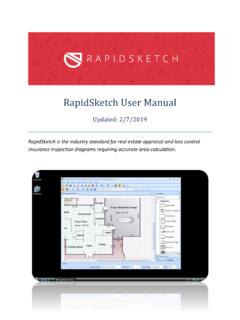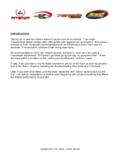Transcription of Fluorescence Microscopy
1 Fluorescence Microscopy Kenneth R. Spring National Institutes of Health, Bethesda, Maryland, INTRODUCTION fluorochromes (also called fluorophores), which are ex- cited by specific wavelength irradiating light and emit When organic or inorganic specimens absorb and sub- light of useful intensity. Fluorochromes are stains that sequently reradiate light, the process is typically a result attach themselves to visible or subvisible structures, are of Fluorescence or phosphorescence. Fluorescence emis- often highly specific in their attachment targeting, and sion is nearly simultaneous with the absorption of the have significant quantum yield (the photon emission/ab- excitation light as the time delay between photon ab- sorption ratio). The growth in the use of fluorescent mic- sorption and emission is typically less than a microsec- roscopes is closely linked to the development of hundreds ond.
2 When the emission persists long after the excitation of fluorochromes with known intensity curves of exci- light is extinguished, the phenomenon is known as phos- tation and emission and well-understood biological struc- phorescence. Stokes coined the term Fluorescence '' in ture targets. the middle of the 19th century when he observed that the mineral fluorspar emitted red light when it was il- luminated by ultraviolet (UV) excitation. Stokes noted EXCITATION AND. that the Fluorescence emission always occurred at a EMISSION FUNDAMENTALS. longer wavelength than that of the excitation light. Early investigations showed that many specimens (minerals, The basic task of the Fluorescence microscope is to ir- crystals, resins, crude drugs, butter, chlorophyll, vita- radiate the specimen with the desired wavelength and then mins, inorganic compounds, etc.)
3 Fluoresce when irra- to separate the much weaker emitted (fluorescent) light diated with UV light. In the 1930s, the use of fluoro- from the excitation light. Only the emission light should chromes began in biology to stain tissue components, reach the eye or other detector so that the resulting fluor- bacteria, or other pathogens. Some of these stains were escing areas are contrasted against a dark background. highly specific and they stimulated the development of The detection limit is largely determined by the darkness the Fluorescence microscope. of the background. The exciting light is typically 105 or Fluorescence Microscopy has become an essential tool 106 times brighter than the emitted light. in biology as well as in materials science as it has at- Fig.
4 1 is a graphical representation of the design of tributes that are not readily available in other optical an epi- Fluorescence microscope. This is basically a re- Microscopy techniques. The use of an array of fluor- flected light Microscopy mode in which the wavelength ochromes has made it possible to identify cells and sub- of the reflected light is longer than that of the excitation. microscopic cellular components and entities with a high Ploem is credited with the development of the ver- degree of specificity amid nonfluorescing material. The tical illuminator for reflected light Fluorescence micro- Fluorescence microscope can reveal the presence of a scopy. In this device, light of a specific wavelength or set single fluorescing molecule. In a sample, through the use of wavelengths, often in the UV, is produced by passing of multiple staining, different probes can simultaneously light from a lamp or other source through a wavelength identify several target molecules.
5 Although the fluores- selective exciter filter. The desired wavelength light re- cence microscope cannot provide spatial resolution below flects off a dichromatic ( dichroic'') mirror, through the the diffraction limit of the respective objects, the de- microscope objective lens to the specimen. If the spe- tection of fluorescing molecules below such limits is cimen fluoresces, the collected emission light then passes readily achieved. through the dichromatic mirror and is subsequently fil- There are specimens that autofluoresce when they tered by a barrier filter that blocks the excitation wave- are irradiated and this phenomenon is exploited in the lengths. It should be noted that this is the only mode of field of botany, petrology, and in the semiconductor in- Microscopy in which the specimen, subsequent to ex- dustry.
6 In the study of animal tissues or pathogens, auto- citation, gives off its own light. The emitted light re- Fluorescence is often either extremely faint or nonspe- radiates spherically in all directions, regardless of the cific. Of far greater value for such specimens are added direction of the exciting light. 548 Encyclopedia of Optical Engineering DOI: 120009628. Published 2003 by Marcel Dekker, Inc. All rights reserved. Fluorescence Microscopy 549. F. Fig. 1 Cut-away diagram of an upright microscope equipped both for transmitted light and epi- Fluorescence Microscopy . The vertical illuminator in the center of the diagram has the light source at one end (episcopic lamphouse) and the filter cube at the other. Epi- Fluorescence is the overwhelming choice in mo- The reflected light illuminator has, at its far end, a dern Microscopy and the reflected light vertical illumin- lamphouse containing a light source, usually a mercury or ator is interposed between the observation viewing tubes xenon burner (the episcopic lamphouse in Fig.)
7 1). The and the nosepiece carrying the objectives. The illuminator light travels along the illuminator perpendicular to the is designed to direct light onto the specimen by first optical axis of the microscope, passes through collector passing the light through the microscope objective on the lenses and a variable, centerable aperture diaphragm, and way toward the specimen and then using that same ob- then through a variable, centerable field diaphragm (aper- jective to capture the emitted light. This type of illumi- tures in Fig. 1). It impinges upon the excitation filter nator has several advantages: the objective first serving where selection of the excitation wavelength light and as a well-corrected condenser and then as the image- blockage of undesired wavelengths occurs.
8 The selected forming light gatherer is always in correct alignment; wavelengths reach the dichromatic beamsplitting mirror. most of the unused excitation light reaching the speci- This is a special type of interference filter that efficiently men passes through it and travels away from the ob- reflects shorter wavelength light and efficiently passes jective; the illuminated area is restricted to that which is longer wavelength light. The dichromatic beam splitter observed; the full numerical aperture ( ) of the ob- (also sometimes called the dichroic mirror, as shown in jective, in Koehler illumination, is utilizable; it is pos- Fig. 1) is tilted at 45 to the incoming excitation light and sible to combine or alternate reflected light Fluorescence reflects the excitation light at a 90 angle directly through with transmitted light observation.
9 The objective and onto the specimen. The fluorescent light 550 Fluorescence Microscopy if the housing is inadvertently opened during operation. The lamphouse should be sturdy enough to withstand a possible burner explosion during operation. The lamp socket should have adjustment screws to permit center- ing the image of the lamp arc or halogen lamp coil to the back aperture of the objective (in Koehler illumina- tion, these planes are conjugate). In the light path, closer to the lamphouse and before the excitation filter, it is desirable to have a shutter for complete blocking of ex- citation light as well as neutral density filters on a wheel or slider to permit reduction of light intensity. STOKES' SHIFT. When electrons go from the excited state to the ground state, there is a loss of vibrational energy.
10 As a result, the emission spectrum is shifted to longer wavelengths than Fig. 2 A microscope filter cube containing the exciter and the excitation spectrum (wavelength varies inversely to barrier filters as well as the dichromatic mirror. radiation energy). This phenomenon is known as Stokes'. Law or Stokes' shift. The greater the Stokes' shift, the easier it is to separate excitation light from emission light. emitted by the specimen is gathered by the objective, now The emission intensity peak is usually lower than the serving in its usual image-forming function. Because the excitation peak; and the emission curve is often a mirror emitted light consists of longer wavelengths, it is able to image of the excitation curve, but shifted to longer wave- pass through the dichroic mirror.




